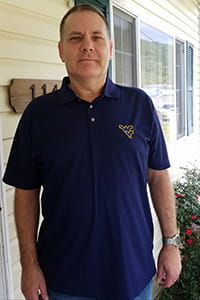Logan, W.Va. is a small town built around coal mining. For Clarence Damron, mining is all his family knows. His grandfather, uncles, cousins, and brothers all worked in the coal mines of southern W. Va. Many of them fell victim to black lung disease, a harmful and sometimes deadly illness.
When Clarence developed the same disease as so many of his family members, he sought a lung transplant. This life-changing surgery has allowed him to live a healthy, active life.
The Challenge: Black Lung
Clarence began working as a coal miner in 1978. He started to have trouble breathing just five years later when doctors diagnosed him with early-stage silicosis. Breathing in tiny bits of rocks and minerals from the mine caused scarring in his lungs.
Another five years later, medical tests showed Clarence’s silicosis had doubled in severity.
Multiple doctors told Clarence to get out of the mines and find other work. But with two children and few other options in his town, that wasn’t a choice.
“In southern West Virginia, coal mining is it. That’s what we thrive on,” Clarence says. “I liked taking care of my kids, so I kept working.”
Clarence's lung function grew worse until, more than 20 years after his mining career began, doctors diagnosed him with black lung disease.
Black lung disease is a form of pneumoconiosis. It’s a common term for any lung disease that affects coal workers because of breathing in coal dust over time.
Black lung disease can have many harmful effects and complications, including severe trouble breathing, chronic bronchitis, inflammation in the lungs, and pneumonia.
After 32 years of working six days a week in the mines, black lung forced Clarence to quit his job. He could no longer sleep lying down because he couldn’t breathe, describing a feeling of being “smothered all the time.” He couldn’t walk more than a few feet without help. He needed an oxygen tank from the day he turned 50.
“Life was miserable,” Clarence says.
Finally, Clarence’s pulmonologist told him if he wanted a chance at being healthy, there was only one real option — a lung transplant.
The Path to a Double Lung Transplant at UPMC
A lung transplant was a foreign idea to Clarence. In his experience, the unavoidable reality was that people died from black lung. He had never considered the possibility of having surgery to recover from this condition.
By this point, Clarence’s quality of life was so low he dreaded waking up in the morning. So, his doctor referred him to UPMC — one of the nation’s leading centers for organ transplantation.
Clarence researched the lung transplant surgeons at UPMC and knew he wanted to receive treatment from them.
Though he felt scared, he had the utmost confidence in his transplant team. And, after preparing for the surgery with the help of his transplant coordinator, Clarence was ready.
The phone call telling Clarence that a pair of lungs was ready for him came on September 2, 2013. He had a double lung transplant the next day.
“I’ve never been in a hospital like that — everybody was just superb,” Clarence says. “The staff, the surgeons, they changed my life. It was the scariest thing, but also the most rewarding thing. To get a second chance at life is just amazing.”
The Result: Breathing Easy
Today, Clarence is 58 years old. He feels even better than he did when he was 30 and walks 15 miles every day.
“10 in the morning and five in the evening,” he says.
He returns to UPMC every six months, and he says it’s just like visiting family.
At an appointment four years after his transplant, his lung function was at 96 percent. This was much higher than his pulmonologist’s expectation of 80 percent.
At home, Clarence is an advocate for people who have black lung disease or related lung conditions.
He's also spent more than 25 years in ministry and continues to spread his faith. He believes it gave him the strength to get through the surgery.
Clarence visits with potential transplant patients at his local hospital to tell his story. He encourages people to seek a lung transplant like he did.
“There is hope. You don’t have to just give up. You don’t have to just sit home like we’ve done here for years,” Clarence says.
Clarence is endlessly grateful to his transplant team at UPMC. His new set of lungs allows him to live a life he thought he lost.
“I love life now,” he says. “I get to hunt. I get to fish. My transplant was just a godsend. There’s nothing like UPMC to me.”
Clarence's treatment and results may not be representative of all similar cases.
Learn More About Lung Transplant
UPMC Transplant Services:
UPMC Health Library



















